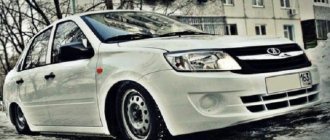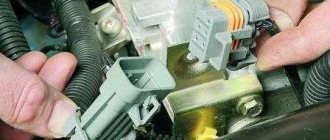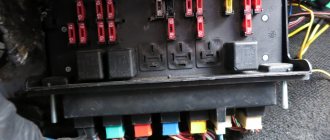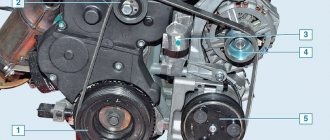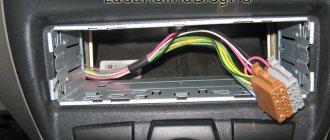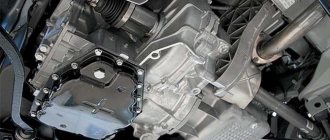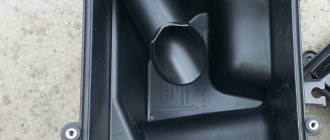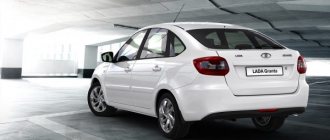What is "failure"? This is an effect in which the car does not accelerate when you press the gas pedal. Usually the failure lasts a few seconds, and then the “jerk” effect occurs. This is a fairly common malfunction associated with the fuel injection system. On Kalina, it does not occur often, but it does happen.
Video about gas failures on an injection engine:
This video material will talk about such a malfunction as gas leaks, the causes of occurrence, methods of elimination, and also contains some recommendations for car owners.
Causes of the phenomenon
Drop in speed and failure of the gas pedal
There are few reasons for the phenomenon of “failure” when pressing the gas pedal. It often appears after unsuccessful engine chip tuning and is accompanied by an increase in fuel consumption, but there are other problems directly with injection. So, let’s look at the main reasons for the “failure” effect:
- Injectors . The fuel distribution system directly affects engine performance.
Identifying and eliminating ECU errors
Condition of the candles. On the left the mixture is too rich, on the right it is too lean.
These are all the main reasons that can lead to gas pedal failure.
Dips during acceleration
Once the causes are considered, we can consider how to deal with the problem. So, let’s describe step by step what needs to be done when the gas pedal has dips during acceleration:
- The first step is to check the spark plugs. The appearance of carbon deposits or spark plugs that are too clean indicate that the mixture is not adjusted correctly. It is worth adjusting the correct amount of fuel mixture.
- Ignition wires can also cause the vehicle to malfunction.
- A clogged throttle can lead to failures during acceleration.
- The condition of the air filter affects the formation of the mixture, so it is worth changing it on time.
Air filter clogged
Dirty fuel filter
Dirty fuel filter
- ECU errors can also lead to accelerator failures.
- The last reason is clogged injectors. They need to carry out diagnostics, check functionality, and also clean and replace faulty elements.
Thus, the causes of failures during overclocking have been identified and can be eliminated.
Gas leaks at idle
At idle, there are fewer reasons for failures, but they will have to be eliminated, since the car simply will not start normally, or stall after starting the engine. So, let's look at the work plan step by step:
- Checking the spark plugs. If the element fails, it is necessary to replace it.
Attention! It is recommended to change all four spark plugs to ensure smooth engine operation. Before installation, you should adjust the gap using a feeler gauge, which should be 1 mm for 92 gasoline.
Checking and adjusting the spark plug gap using a feeler gauge
- We change the fuel filter, it is located under the bottom of the tank, and also carry out diagnostics on the fuel pump. If malfunctions are identified, they should be eliminated.
Clogged filter in the gasoline pump
All these reasons can cause dips to appear at idle (more precisely, when switching from idle to driving mode).
Causes of failures when pressing the gas pedal
Let's look at the main reasons:
- Spark plugs and high-voltage wires;
- Clogged fuel injectors;
- The throttle valve is dirty;
- The ignition is set incorrectly;
- Errors in the ECU;
- The air filter is clogged;
- Problems with the fuel pump.
Often, failures occur due to a breakdown of the power system . After pressing the gas pedal, the power system increases the volume of fuel supplied to the cylinders. Breakage causes a change in these proportions. Those. The motor just can't do its job.
In addition, it is possible that there may be a breakdown in the ignition system . It occurs much less frequently. It's either spark plugs or ignition wires. The spark plugs must be removed and checked. The presence of carbon deposits or too clean spark plugs indicate a rich or lean fuel mixture, respectively. This indicates that the ignition system is adjusted incorrectly.
To ensure that the fuel mixture ignites at the right time, read the article on how to set the ignition correctly.
Dips when pressing the gas pedal during acceleration
It is determined both using computer diagnostics and by the steps described below (some of the points below can be performed independently, but specialists in car services in Moscow will be able to determine the problem area more quickly and accurately):
- The first thing you need to do is inspect the spark plugs. To do this you need to remove them. The presence of carbon deposits on the spark plugs, poor contact with the wires, or an excessively lean or rich mixture lead to spark plug malfunctions.
- High voltage wires can also cause engine malfunction, as can ignition coils.
- The throttle needs to be checked. If it is clogged, this causes the engine to respond untimely when pressing the gas pedal.
- It is necessary to check the condition of the air, fuel and oil filters. They tend to get clogged, which worsens dynamics, increases fuel consumption and causes pedal failure. They need to be changed constantly, you can do it yourself, they are inexpensive and easy to install.
- The presence of errors in the ECU leads to failures.
- Clogged injectors. If necessary, replace or repair injectors .
The wires, as well as the rubber bands on them, should not be damaged and should not spark when the engine is running. If damage is found, this indicates that the engine is shaking and jerking begins. This may occur due to the age of the car, worn-out or low-quality spare parts, poor contact with the spark plugs, or due to the temperature of the engine.
The resistance of the coils and the temperature change together, as a result of which a gasoline car begins to jerk during acceleration. In diesel cars, jerking cannot be associated with the coils, since they are not present.
Dips when pressing the gas pedal at idle
Problems also occur at idle speed; of course, there will be fewer reasons. However, this is also a serious problem and cannot be ignored, because... The car will have difficulty starting and simply stall.
Troubleshooting is performed in the following order:
- The first thing to check is the spark plugs. If the spark plugs are faulty, they should be replaced. We recommend replacing all spark plugs at the same time. Buy spark plugs specifically for your engine. If necessary, adjust the gap; it should be 1 mm for 92 gasoline.
- The fuel filter and fuel pump diagnostics are checked. If a malfunction is identified, fix it.
- The breakdown may be in the idle speed sensor.
- Checking the injectors. If clogged, replacement or cleaning is necessary.
- Diagnostics of the ECU for errors.
- Checking the injector.
conclusions
The main cause of failures are spark plugs, but they are not the only ones that influence the appearance of this effect. Some car enthusiasts may not be able to cope with the occurrence of such malfunctions on their own, and it is necessary to go to a car service center, where they will carry out high-quality diagnostics and also fix the problem. But it is worth considering that you will have to be generous, since neither computer diagnostics nor repairs will cost a penny.
Sometimes motorists are faced with such an infrequent, but extremely unpleasant phenomenon as failures when pressing the gas pedal on the injector of a VAZ 2114. In short, such failures are the lack of a quick response from the car engine to pressing the gas pedal. We will talk about why they can arise and how to eliminate them on your own in today’s article.
What did I do
I did not self-medicate, because, as experience shows, this is a waste of money in the absence of a convincing positive effect.
- I did computer diagnostics, according to the results of which long-term fuel corrections were in the positive: the engine does not have enough fuel-air mixture. The control unit compensated for this deficiency by increasing the opening time of the injectors, so the car “stuck” at the start. The MAF sensor readings were low, indicating that the air filter was dirty.
- I changed the air filter because it had become clogged during my summer travels.
- My spark plugs are excellent, there is no carbon deposits. Despite my creativity, I do not change the brand of fuel station; I try, as they say, not to look for good from good.
- I changed the fuel filter, and not just changed it, I flushed the fuel system. Previously, I did this procedure once a year on all my cars, I always liked the way the car was after it - playful and responsive, reacting to the gas pedal immediately when pressed.
Features of failures
What all pedal failures have in common is that when you press the pedal, the engine does not respond in a timely manner, and therefore does not gain momentum. Such failures can appear in different situations and the behavior of the machine can also be different.
So, we can highlight:
- Short dips while driving (no more than a couple of seconds) followed by a quick response from the engine.
- Dips during acceleration.
- Dips at idle speed.
- Prolonged failures, as a result of which the car stalls.
- Jerking, characterized by a series of alternating short dips and subsequent jerks.
There are not many reasons for this phenomenon, so finding and eliminating them will not be difficult for an experienced driver.
In 99% of cases, failures can be caused by one of the following reasons:
If you notice even minor changes in the “behavior” of the engine, you should end the trip as quickly as possible and visit a car service center or perform independent diagnostics and repairs. Continuing to drive a car with dips is not only harmful to the car itself, but also extremely dangerous.
Dips during acceleration
Most often, in the VAZ 2114 car, failures when pressing the gas injector occur during acceleration.
If you are faced with a similar situation, then the search for its problem should be carried out in the following sequence:
- If the spark plugs are oxidized or covered with soot, they should be cleaned with a cloth with kerosene or fine sandpaper (or replaced if they cannot be restored). In addition, the composition of the fuel mixture should be adjusted, since very often the cause of soot on the spark plugs is precisely its incorrect composition.
If on your VAZ 2114 failures occur when you press the gas injector while driving, then using the above plan you can easily find the causes of this phenomenon and be able to eliminate it.
How to Avoid Failures
Having talked about how to eliminate gas pedal failures that occur on a car, it is worth talking about how to completely avoid their occurrence. So, the most common cause of their occurrence is wear of the spark plugs. Therefore, you should always check their condition, prevent clogging and oxidation, and, if necessary, replace them.
It is worth remembering that it is highly recommended to replace spark plugs as a “set”, even if only one of them is seriously damaged.
In addition to spark plugs, high-voltage wires should also be periodically monitored (despite the fact that they have a long service life, core breaks and breakdowns of protection are far from uncommon).
Another very common cause is clogged filters, and especially the air filter. This element is a direct participant in the chain of formation of the working mixture, and that is why its contamination (or even damage) can immediately affect the operation of the engine.
The last thing you should pay attention to in order to avoid unpleasant gas failures is the quality of the fuel. If you notice that at the nearest gas station it has dropped significantly (and the car reacts to this), then you should not continue to use it - it is better to try refueling at a pump of another company (or several companies). In this way, you can find the highest quality gas station and ensure reliable operation of your car’s engine.
Failure is always bad, no matter in what context this word is said. In the case of the gas (accelerator) pedal, this is also unpleasant, moreover, it is dangerous, because instead of sharp acceleration, the driver gets a dip and complete inactivity of the engine. As you understand, at speed, during overtaking, this phenomenon can end badly...
As I already said, failures when pressing the gas pedal are the lack of response of the engine to pressing the gas pedal, that is, you pressed the pedal, but there is no acceleration. As a rule, the pickup still occurs, but with a delay; moreover, the response can manifest itself in the form of a sharp push or jerk, which also does not bring anything good. For example, on a slippery road, a jerk can result in loss of control or lead to an accident.
Such a malfunction is usually associated with the fuel system, but there may be other reasons why failures occur when pressing the gas.
What to do if the car stalls when accelerating?
Let's look at the following positions:
- Air filter. A dirty air filter reduces the air supply to create a fuel-air mixture - a lean mixture leads to a drop in engine power and increased fuel consumption. The quality of the air filter material also affects engine performance - don’t go cheap. To check your air filter, open the hood, remove the filter element from the housing and assess the condition. If you can already plant potatoes on it, change it urgently.
- Spark plug. They may well be excessively worn or dirty, if the engine does not pull because of them - replace the spark plugs, this is a relatively inexpensive option for troubleshooting. However, it should be borne in mind that soot, oil or brake fluid contamination is not normal, and the reason for this is not so much in the spark plugs as in the rest of the engine components.
- Fuel. Remember where you last refueled - perhaps it was a new gas station, or one whose fuel you had no experience using before - it is quite possible that the problem is the low quality of gasoline. Along with a decrease in torque, low-quality fuel causes instability in engine speed, difficulty starting and some other problems - depending on how bad the fuel is and what model of car.
- Fuel filter. Just like an air filter, it can cause a loss of engine power, the physics of the process here is similar to an air filter - if in the case described above the fuel did not burn completely due to lack of air, then in the case of a dirty fuel filter, on the contrary, an insufficient amount of fuel is supplied. The problem is solved by replacing the fuel filter.
